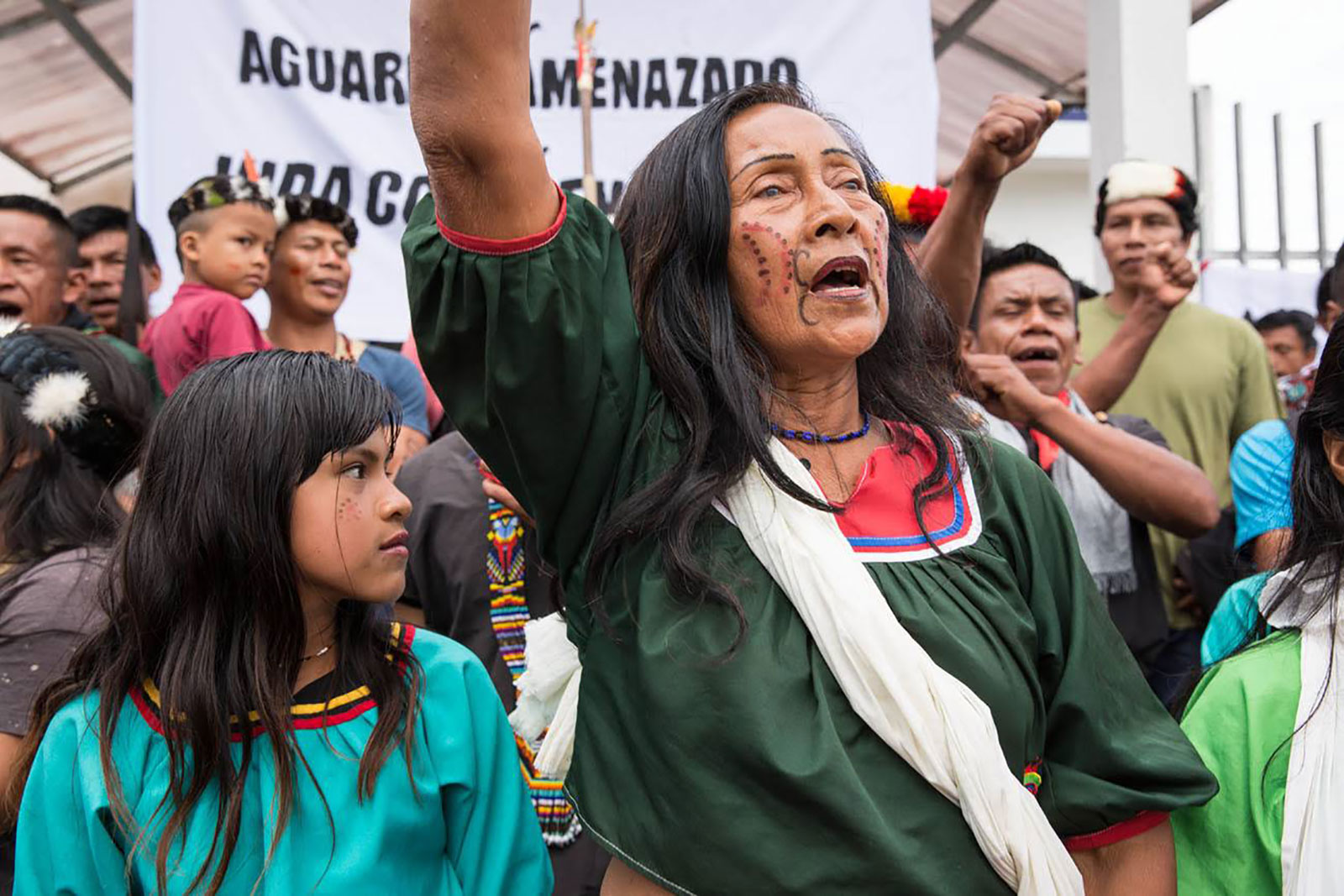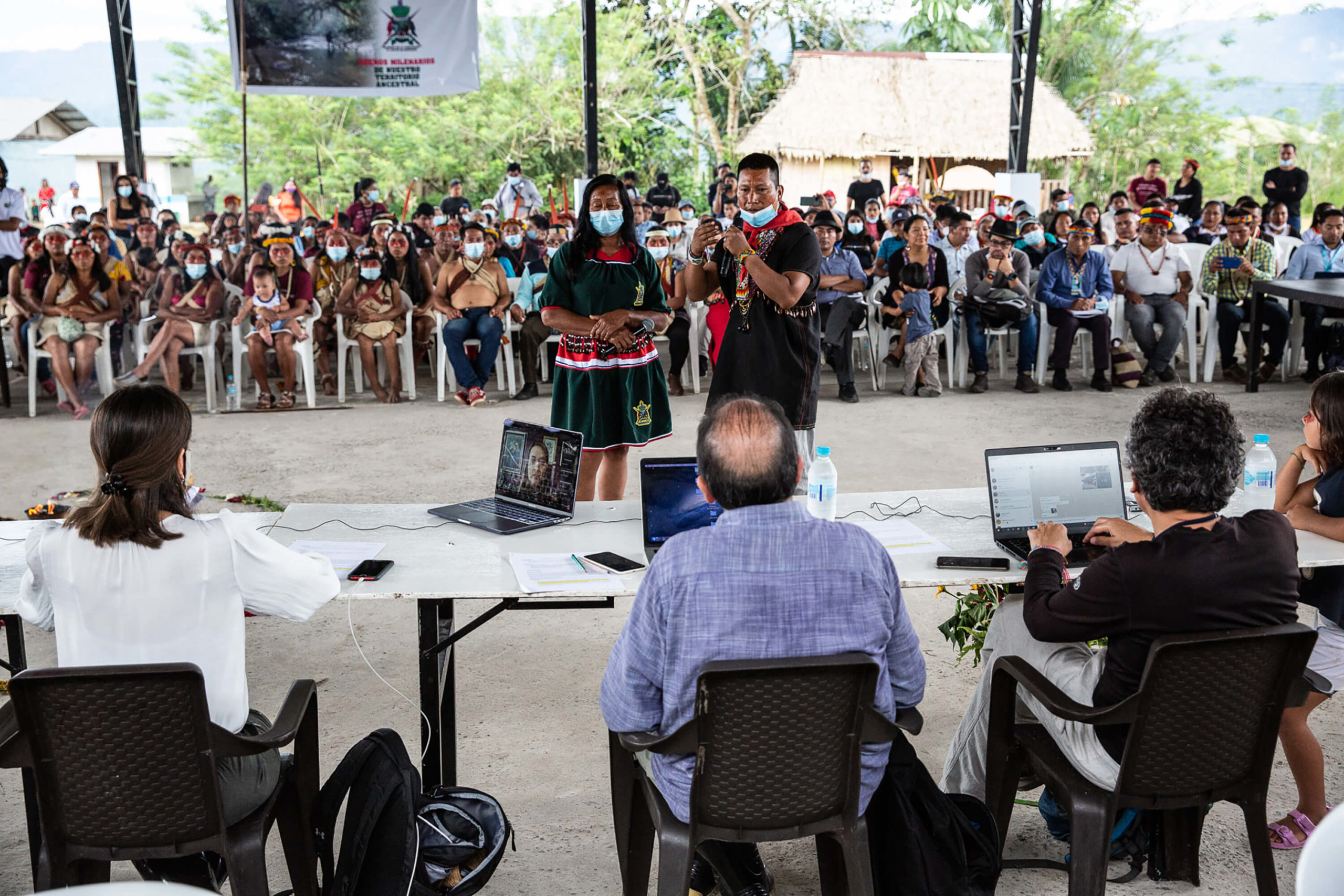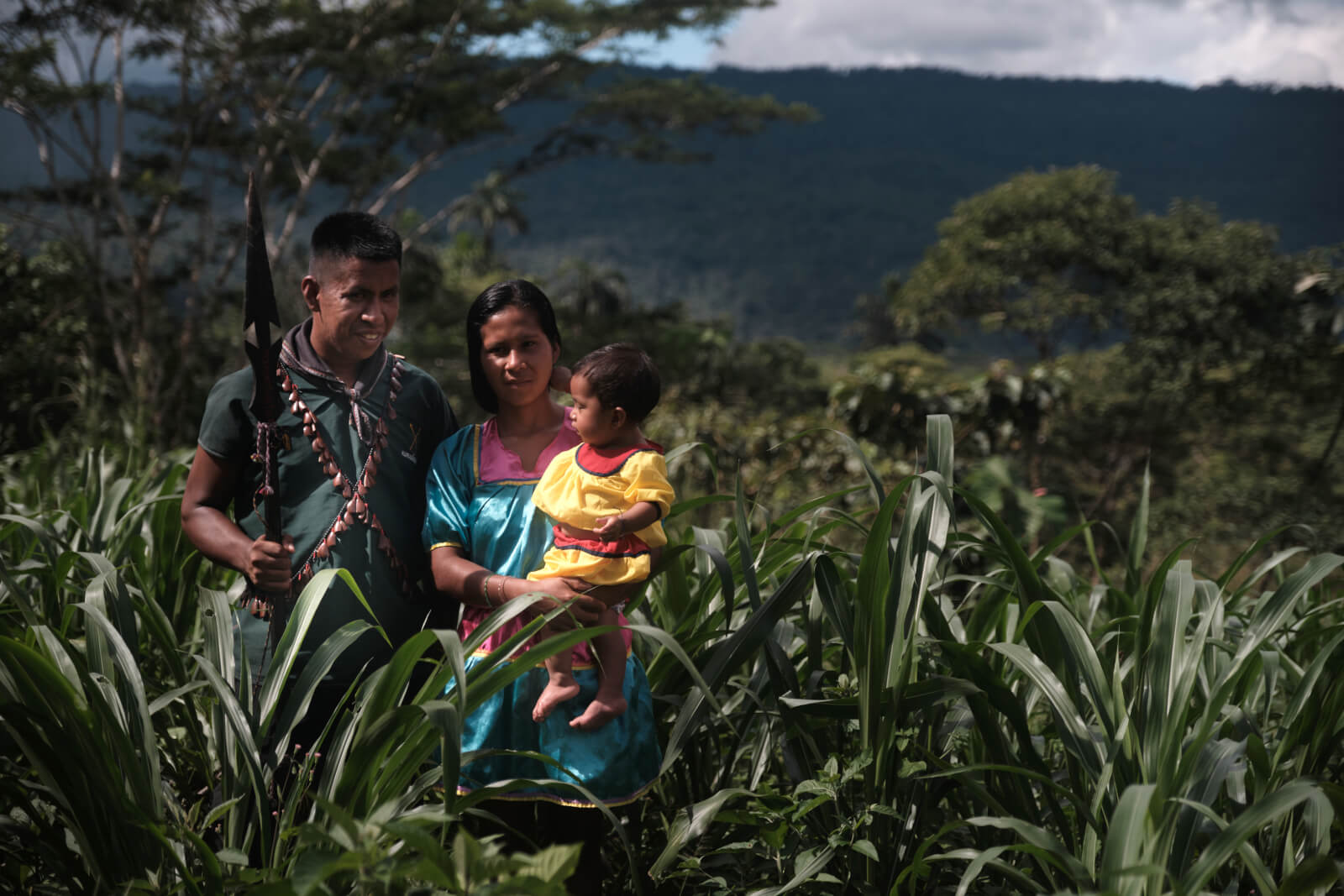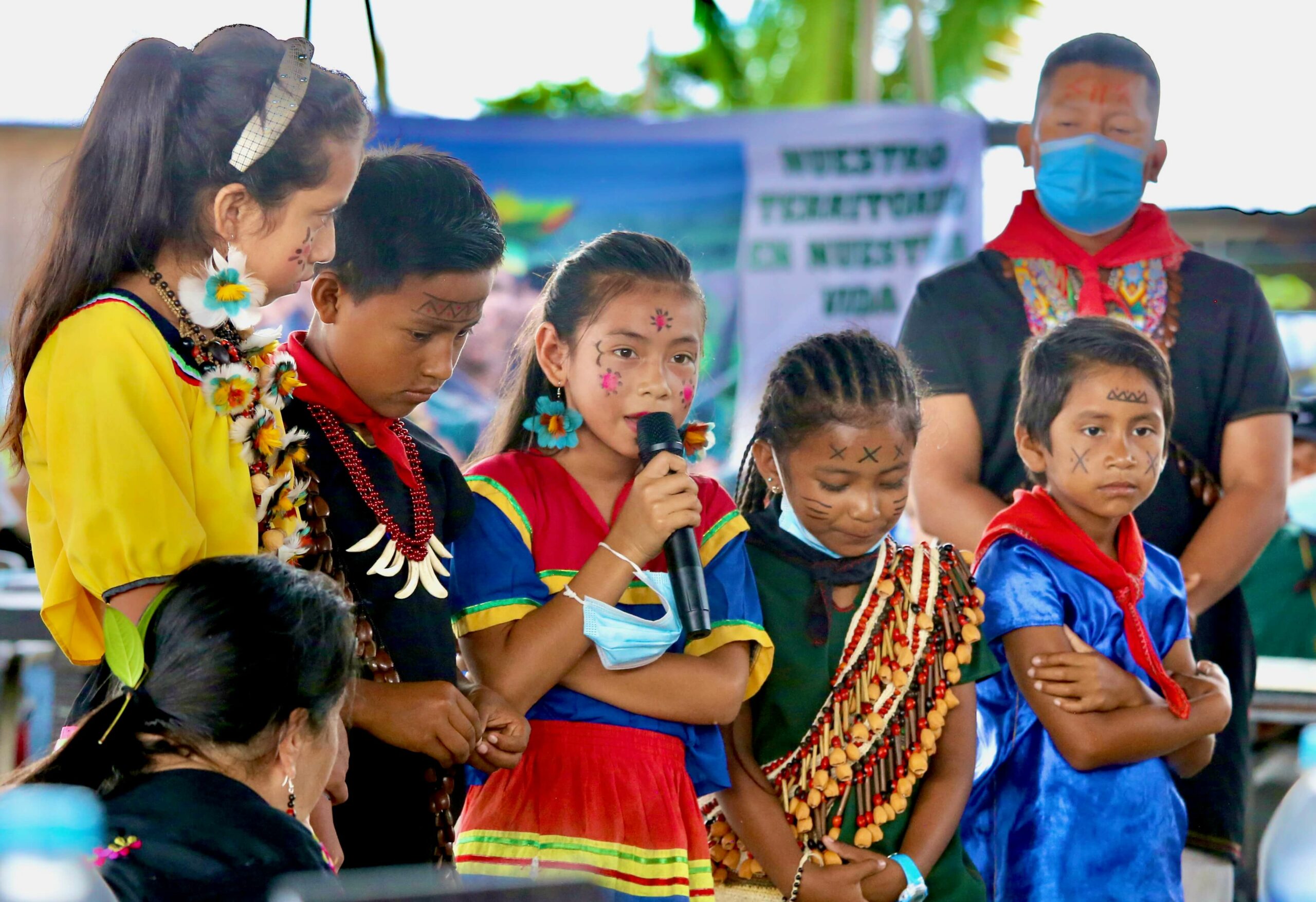Breakdown
- The climate and ecological crisis is worsening, in large part due to the expansion of extractivist projects onto protected and ancestral territories, home to Indigenous communities. These projects are being imposed in the name of ‘development’, without the consent of Indigenous communities.
- The A’i Cofán community of Sinangoe, through a grassroots organizing process involving hi-tech environmental monitoring, the leadership of young voices, and the formation of the Indigenous guard, has been successful in resisting the invasion of mining interests onto their territory.
- Through strategic litigation, they have managed to secure unprecedented victories in Ecuador’s courts, including the country’s Constitutional Court, which enshrine and affirm the right of communities to decide over their own territories and lives, and say “no” to extractive projects. One year on, the Ecuadorian government is still failing to comply with the ruling.
In the foothills of the Ecuadorian Andes, by the shores of the Aguarico River, lies the ancestral territory of the A’i Cofán people of Sinangoe . Here, the mountains meet and merge with dense forest, forming an area with the highest level of species per hectare in all Ecuador. “This is where our life, our food, our medicine, and everything is”, as A’i Cofán President of Sinangoe Wider Guaramag says.
For years, the Sinangoe community had been resisting, monitoring and documenting illegal gold miners and poachers, entering and polluting the territory. Causing deforestation, damaging the riverbed, and frequently leading to toxic mercury pollution, mining directly threatens the A’i Cofán territory, its way of life, and its communal health.
And then, came another brutal blow. Between December 2017 and February 2018 the Ecuadorian government granted fifty-two gold mining concessions across 32,000 hectares in the headwaters of the Aguarico River. Without any free, prior and informed consent from the A’i Cofán or any communities downstream, and in violation of the national Constitution, Sinangoe and the surrounding primary rainforest was designated by the Ecuadorian government as a zone for permitted extraction.

The Indigenous guard of Sinangoe detects mining on the banks of the Aguarico river in their ancestral territory, January 2018
In response, with the support and solidarity of other Indigenous nations and organizations aligned with the struggle, the A’i Cofán took five government ministries and agencies to court for granting the concessions, and requested a protective action to stop the mining. And in a historic decision in July 2018, a regional judge upheld the claim, charging the Ecuadorian state with a violation of the community’s right to free, prior and informed consultation. The judge proceeded to suspend all mining operations in the territory. Ecuador’s state authorities appealed, but the A’i Cofán community responded by seeking the full revocation of the concessions, and a recognition that their fundamental rights (to health, water, and a clean environment) and the rights of nature were violated. In October 2018, a provincial court would cancel all fifty-two concessions, require the reparation of the areas affected by mining, acknowledge the violation of the right to prior consultation, and reaffirm the community’s rights and the rights of nature. This victory enshrined a significant legal threshold, and offered a juridical tool for all Indigenous communities in Ecuador resisting the encroachment of mining.
But that wasn’t the end of the story. In 2019, Ecuador’s Constitutional Court used the Sinangoe case to embark on a revision of constitutional criteria that guarantee Indigenous rights. On February 4th 2022, the Court ruled that the Ecuadorian state and all other actors, have the obligation to to obtain the consent of the affected communities before undertaking oil, mining or other extractive plans or projects, based on Indigenous peoples’ right to self-determination. This is the Sinangoe precedent.

A’i Cofan community members of all generations raise their voices in defense of their ancestral rainforest territory and way of life during a mobilization outside a provincial court in 2018
I. What is the precedent?
On February 4th 2022, Ecuador’s Constitutional Court, the most powerful court in the country, delivered a landmark ruling which recognised the rights of Indigenous communities to have a final say over extractive projects which affect their territories. The ruling offers one of the strongest legal precedents in the world which upholds the rights of Indigenous peoples to decide on the futures of their ancestral territories. As Maria Espinosa, Amazon Frontlines Legal Coordinator and the lead lawyer on the Sinangoe case explains, “in the precedent, the Court recognise the right to prior consultation and consent, and understands this right as an integral right, that protects not just the participation of communities, but also the property, self governance, and self-determination of Indigenous peoples. Across all the rulings by the courts, from the provincial court to the Constitutional Court, the justice system also recognise the special value that ‘territory’ has for Indigenous peoples, that the territory is not an object, but a subject of rights.”

For the first time in history, judges from Ecuador’s highest court hear oral argument to set national precedent on perhaps the two most important rights for Indigenous guardianship of our planet’s most important rainforest: the rights of nature and the right to say “no” to extractive projects, November 2021
II. Why is the precedent so important?
Firstly, because on this day, it may be considered one of the highest rulings in favor of Indigenous rights in Ecuadorian history, setting a momentous legal precedent throughout the country and becoming a point of reference around the world. Given the status of the Constitutional court, the ruling is binding: the Ecuadorian state and companies on its territory must abide by it, in all contexts. The decision applies not just to the A’i Cofán community in Sinangoe, but to all Indigenous peoples in Ecuador. The Sinangoe ruling can now be a powerful legal tool and instrument that can be used by all nationalities and communities to resist extractive encroachment, and protect their territories. Already, other communities in other continents have cited the precedent to give more weight to their own cases of land protection. In Ratuati Irara (the Tiwi Islands, Australia), Tiwi islanders won a historic case protecting their waters from corporate gas drilling, after the company failed to adequately consult the community; the Sinangoe case was cited as precedent in the trial. The U’wa community of Colombia are also recurring to the Sinangoe precedent in its case before the Inter-American Court of Human Rights, where they are seeking justice over the lack of protection over their ancestral property rights in the face of multiple extractive activities.
Secondly, because it helps secure the right to free, prior and informed consent (FPIC) in reality, not just in theory. Both in Ecuador and other countries around the world, this right has been regarded as voluntary and non-compulsory for extractive companies and state agencies, and has therefore, been consistently violated. When applied, consultation typically is applied as a process of informing communities about projects to be developed on their territories, without respecting their rights or wishes.
The Sinangoe precedent however also clearly frames consultation as consent, giving communities the right to reject or veto extractive projects, and compels companies and states to respect the decisions of Indigenous communities.
Thirdly, the Sinangoe precedent matters because it is a crucial piece of legislation to help protect biodiverse ecosystems. These ecosystems, through the carbon they absorb and the life cycles they nourish, are indispensable for tackling the climate emergency. Indigenous communities, through their ecological knowledge and stewardship, are guardians of around 80% of our planet’s biodiversity. The dignified survival of Indigenous communities, and the territories they sustain, depends on them maintaining the power to decide over their own territories. All communities have the right to ‘say no’ to extractive projects on their own territories. The Sinangoe legal precedent defined by Ecuador’s Constitutional Court re-affirms this right, and directly contradicts the position of Ecuador’s Ministry of Energy, which had granted the gold concessions in the first place. Future attempts to establish extractive projects on Indigenous territories will have to abide by the standards of this sentence. In this regard, the precedent serves as a powerful instrument to protect highly-biodiverse territories in the future.

A’i Cofan family of Sinangoe in their ancestral territory in the Ecuadorian Amazon, along one of the country’s most important Amazonian headwaters
III. How was it achieved?
The legal victories of the A’i Cofán community of Sinangoe stems from a long history of rigorous monitoring, struggle, innovation, and resistance, in the face of colonial and extractive interests.
In 2017 the A’i Cofan in Sinangoe established their own Indigenous law and guard (Guardia Indigena), designed to protect their territory from invasive, extractive activity. Additionally, in collaboration with the Ceibo Alliance and Amazon Frontlines, the Sinangoe community led a rigorous monitoring project, using cutting-edge technology – from trap cameras to drones to satellite imagery – to assemble high-quality data about their territory that could inform processes to defend their land. The meticulous evidence from community mapping and monitoring, capturing examples of illicit extraction, helped the community demonstrate the extent of mining before the Ecuadorian courts.
The Guardia’s development was nourished by the revival of cultural practices, such as the drinking of yagé with elders and wisdom-keepers. As A’i Cofan leader Alex Lucitante would remark in 2018, “First the struggle emerged and then the cultural recovery – and now all of this continues.” Through yagé rituals, the construction of a ceremonial house, and dialogue, the community bolstered its own strength and unity.
After the community first discovered the illegal and state-authorized mining taking place on their territory, the community began to engage each one of its members, consolidating a process geared towards communal strengthening and the permanent protection of their rainforest home. Everyone in the community, from children to young people to elders, participated based on their understanding of their culture and territory. As lawyer Maria Espinosa explains, “It was and continues to be a process that isn’t rushed – it was designed to understand, attend to, and incorporate all the perspectives and knowledges diverse members of a community have. It was a strategy not just to present a legal case, but a collective process to understand the depth and breadth of their own rights.”
From that place of collective power, the A’i Cofán in Sinangoe – supported by the Ceibo Alliance and Amazon Frontlines – developed a long-term strategic litigation campaign. Regular community meetings were conducted, disseminating updates, and spreading tasks relevant to the legal campaign efficiently throughout the community.
The legal victories around Sinangoe were also spearheaded by young A’i Cofán leaders, including Alexandra Narvaez and Alex Lucitante, who co-received the prestigious Goldman Prize in 2022. They represent a path-breaking new generation of leadership, committed to protecting their territory and nourishing the cultural thriving of their peoples.
Three years after the start of the legal process, in a testament to the community’s organising power, in November 2021, five Constitutional Court judges traveled deep into the northern Amazon rainforest to Sinangoe. For the first time in the legal history of Ecuador, the country’s highest court held a hearing on Indigenous territory. This allowed the judges to get to know Sinangoe’s ancestral territory firsthand, and enabled the entire community to be present and heard, as well as up to 300 Indigenous leaders from across the Amazon and the country.

A’i Cofan children of Sinangoe present their testimonies to the judges of the Constitutional Court, demanding that their rivers remain healthy and their forests protected, November 2021
IV. What do we do now to advance the Right to Decide?
One year on, it is time to ensure that the precedent and its ruling be implemented. Today, there are still many extractive projects on Indigenous territories in Ecuador and across the Amazon, and more are being planned, without consent and in violation of multiple Indigenous rights. Nearly 70 percent of Ecuador’s rainforest has been conceded to oil companies.
The gap between rights on paper and rights in reality remains far too large. In spite of the precedent, A’i Cofán community is still demanding that the Constitutional Court’s ruling be applied, that the relevant agencies archive all concessions, and that the rights violation and the forest be remedied. The Sinangoe community itself returned to Quito in September 2022 to present non-compliance action before the Constitutional Court, demanding they apply what they ruled on. Other communities, such as the Waorani, who also secured legal victories against oil concessions in 2019, are also calling for the effective implementation of their rulings.
It’s time to push the Constitution and these rights into reality. As Alexandra Narvaez said on the steps of the Constitutional Court, “this is a millenary struggle from our ancestors – today, as women, as young people, we are saying we do not want mining, we want life, and a future for our and all children. We are all connected through territories.”
Together, through our alliances and connections, we can help to protect the rights of Indigenous communities to their territories and ways of life.





